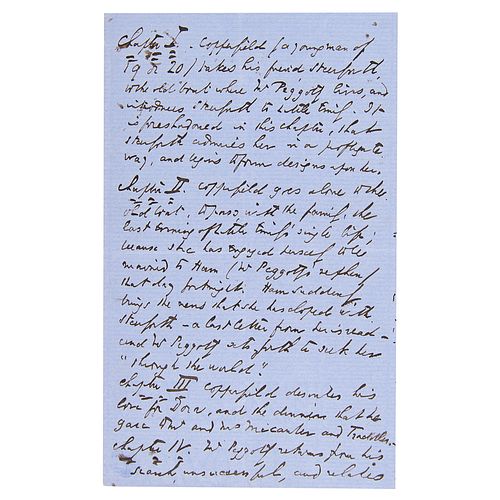Charles Dickens Handwritten Outline for 'David Copperfield'
Two ways to bid:
- Leave a max absentee bid and the platform will bid on your behalf up to your maximum bid during the live auction.
- Bid live during the auction and your bids will be submitted real-time to the auctioneer.
Bid Increments
| Price | Bid Increment |
|---|---|
| $0 | $5 |
| $50 | $10 |
| $200 | $25 |
| $500 | $50 |
About Auction
Oct 12, 2022
RR Auction support@rrauction.com
- Lot Description
Handwritten manuscript by Charles Dickens for a six-chapter outline of a stage performance of David Copperfield, two pages on two adjoining sheets, 4.5 x 7.25, no date. Designed for a performance of about two hours long, the outline reads, in full: "Chapter I. Copperfield (as a young man of 19 or 20) takes his friend, Steerforth, to the old boat where Mr. Peggotty lives, and introduces Steerforth to Little Emily. It is foreshadowed in this chapter, that Steerforth admires her in a profligate way, and begins to form designs upon her. Chapter II. Copperfield goes alone to the old boat, to pass with the family, the last evening of Little Emily’s single life; because she has engaged herself to be married to Ham (Mr. Peggoty’s nephew) that day fortnight. Ham suddenly brings the news that she has eloped with Steerforth—a last letter from her is read—and Mr. Peggotty sets forth to seek her 'through the world.' Chapter III. Copperfield describes his love for Dora, and the dinner he gave to Mr. and Mrs. Micawber and Traddles. Chapter IV. Mr. Peggotty returns from his search, unsuccessful, and relates where he has been in France and Italy. Chapter V. Copperfield describes how he made proposals to Dora—how he married Dora—and what their little ménage was. Chapter VI. describes the storm at Yarmouth, in the words of the book, and the Death of Steerforth." In fine condition.
Charles Dickens first published David Copperfield as a serial in 1849-1850 and found modest (for him) success—sales of the serial version reached 25,000 copies in two years, considerably less than what he achieved with Dombey and Son (32,000) and Bleak House (35,000). Nevertheless, Dickens was pleased with the reception of the semi-autobiographical tale—it was his favorite work—and began the ambitious task of compressing it into a two-hour stage show, to be performed as one of his ever-popular 'Readings.' In January 1855, Dickens wrote of his struggle to do so: 'I have been poring over Copperfield (which is my favorite), with the idea of getting a reading out of it, to be called by some such name as 'Young Housekeeping, and Little Emily.' But there is still the huge difficulty that I constructed the whole with immense pains, and have so woven it up and blended it together that I cannot yet so separate the parts as to tell the story of David's married life with Dora, and the story of Mr. Peggotty's search for his Niece, within the time.'
By the time of his first Copperfield reading—performed some six years later, on October 25, 1861—he had reduced the 64-chapter, 358,000-word novel to a six-chapter, 26,500-word script. This manuscript outline of the six chapters is discussed and quoted in full in Malcolm Andrews' 2007 study, Charles Dickens and His Performing Selves: Dickens and the Public Readings. Andrews writes: 'Dickens had great difficulty in designing a Reading from Copperfield…His practice in devising the other Readings had been to condense a complete short story ('A Christmas Carol'), to extract a single episode ('Bardell and Pickwick'), or to concentrate on a character study ('Mrs. Gamp'). With Copperfield he was trying to do all three, to varying degrees: he wanted to encompass a developing narrative (the story of Emily and Steerforth); he wanted to feature some of the famous characters (the Micawbers, Mr. Peggotty); and he wanted some strong single episodes (most notably the storm at Yarmouth)…The organization of the Reading is masterly. Dickens had shaped the narrative into a sequence of striking scenes, finely adapted for performance—'a series of tableaux,' as one reviewer put it.' Dickens immortalized the role of Mr. Peggotty throughout the 71 performances of the reading, which became—like its source material—his personal favorite. The storm scene, which he saved for the finale, has been hailed as the most sublime moment in all of Dickens' readings. - Shipping Info
-
Bidder is liable for shipping and handling and providing accurate information as to shipping or delivery locations and arranging for such. RR Auction is unable to combine purchases from other auctions or affiliates into one package for shipping purposes. Lots won will be shipped in a commercially reasonable time after payment in good funds for the merchandise and the shipping fees are received or credit extended, except when third-party shipment occurs. Bidder agrees that service and handling charges related to shipping items which are not pre-paid may be charged to a credit card on file with RR Auction. Successful international Bidders shall provide written shipping instructions, including specified Customs declarations, to RR Auction for any lots to be delivered outside of the United States. NOTE: Declaration value shall be the item’(s) hammer price and RR Auction shall use the correct harmonized code for the lot. Domestic Bidders on lots designated for third-party shipment must designate the common carrier, accept risk of loss, and prepay shipping costs.
-
- Buyer's Premium



 EUR
EUR CAD
CAD AUD
AUD GBP
GBP MXN
MXN HKD
HKD CNY
CNY MYR
MYR SEK
SEK SGD
SGD CHF
CHF THB
THB












